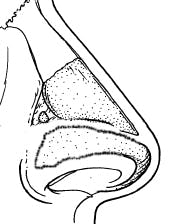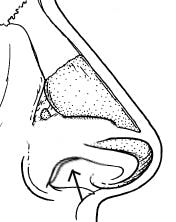
Alar Retraction
After aggressive rhinoplasty, a portion of the nose termed the ala can retract. In primary rhinoplasty, it is beneficial to preserve existing structures of the nose in an effort to decrease the chance of this occurring. In revision rhinoplasty, patients may need correction of alar retraction.
Recently, a paper based on alar retraction with Dr. Shah as a coauthor and co-researcher provided new insight into the process of alar retraction.


Figure a demonstrates normal lower lateral cartilage intact with alar rim. Figure b demonstrates how resection of the lower lateral cartilage can lead to elevation of the alar rim (see arrow).


Patient in preoperative photo on figure a demonstrates retraction of her ala. Her alar retraction was as a result of overaggressive excision (nearly entirely removed) of her lower lateral cartilages creating a host of abnormalities in her nose including harsh cartilaginous details throughout the nose and more of a “scoop then she desired”. She had a revision rhinoplasty performed by Dr. Anil Shah (figure b) in which her nose was created to look closer to her original nose. Her alar rim was recreated with a combination of a cartilage graft in her left lower lateral cartilage and a modified alar rim graft to create an improved transition from her nasal tip to the ala. Her nasal tip was softened to remove her bossa from original surgery.
What is alar retraction?
Alar retraction is when the ala (or part of the nose near the tip) contracts upward, leaving the patient with excessive nostril show.
What causes alar retraction?
If you read the medical literature prior to 2007 it was thought only to be due to previous surgery. In a paper, we found that 50% of patients had preexisting alar retraction congenitally (from birth) and 50% had alar retraction from previous surgery.
So what are the surgical causes of alar retraction?
A classic tenant taught to every rhinoplasty surgeon is it is not how much you take out but how much you leave behind. This refers to the amount of cartilage left behind in the lower lateral cartilage is more important than the amount taken out.
Our study actually proved this tenant wrong. Leaving a little bit of cartilage behind will likely maintain or exacerbate alar retraction. However, taking out greater than 4 mm of lower lateral cartilage also increased alar retraction. Why does this happen? Because excessive space is now created above the ala (supraalar crease) and the cartilage can contract up over time lifting the alar cartilage.
How do you prevent alar retraction?
Quick answer: don’t remove excessive amounts of cartilage and if you do remove more cartilage, place cartilage grafts.
So what are the techniques to lower alar retraction?
Alar batten grafts
Alar rim grafts
Composite grafting
Cartilage repositioning
Depends on the amount of alar retraction
“The nose should fit the face”
A strong jawline would suggest a stronger nose.


